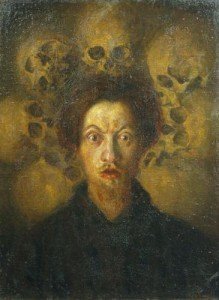Instruments
Intonarumori
The Intonarumori were a family musical instruments invented in 1913 by italian futurist painter and musical composer Luigi Russolo. They were acoustic noise generators that permitted to create and control in dynamic and pitch several different types of noises.

The Intonarumori were a family musical instruments invented in 1913 by italian futurist painter and musical composer Luigi Russolo. They were acoustic noise generators that permitted to create and control in dynamic and pitch several different types of noises.

Each instrument was made of a wooden parallelepiped sound box with a carton or metal speaker on its front side. The performer turned a crank or pressed an electric button to produce the sound whose pitch was controlled by means of a lever on top of the box. The lever could be moved over a scale in tones, semitones and the intermediate gradations within a range of more than one octave.

Inside the box there were a wooden or metal wheel (whose shape or diameter varied depending on the model) that make a catgut or metal string vibrate. The tension of the string was modified by means of the lever allowing glissandos or specific notes. At one end of the string there is a drumhead that transmits vibrations to the speaker.

There were 27 varieties of intonarumori with different names according to the sound produced: howling, thunder, crackling, crumpling, exploding, gurgling, buzzing, hissing and so on.
The invention of the intonarumori was the natural outcome of Russolo’s musical theories expounded in his 1913 manifesto L’arte dei rumori (The Art of Noise) in which he presented his ideas about the use of noises in music.

The first public appearance of the intonarumori took place in 1913 at Modena’s Teatro Storchi, where Russolo presented an “exploder”. In 1914 he took concerts in Milan (Teatro Dal Verme), Genoa (Politeama) and London (Coliseum). In 1921, after WWI, he presented three concerts in Paris (Théatre des Champs-Elysées) and, in 1922, participated in Filippo Tommaso Marinetti’s play Il tamburo di fuoco with some musical backgrounds made with the intonarumori.

Apart from the 1913 manifesto, Russolo exposed his ideas in an article entitled Grafia enarmonica per gli intonarumori futuristi (Enharmonic Notation for the Futurist Intonarumori) published by the Lacerba magazine, where he introduced a new type of musical notation which is still in use among electronic music composers; and in his 1916 book L’arte dei rumori (The Art of Noises).

Luigi Russolo’s work drawed attention of composers and artists like Honegger, Strawinsky, Ravel, the Group of Six, Milhaud, De Falla, Casella, Varèse (who also presented, in 1929, Russolo’s last public concert during the inauguration of an exhibition of futurist painters at the Galerie 23 in Paris), Kahan, Diaghilev, Claudel and Mondrian who wrote about the intonarumori in an article for the De Stijl magazine.

















Having used Theramin devices in recordings, i have at last heard the contours of SOUNDNOISE produced by Intonarumori as conserved on this site… and i find the effect quite stimulating and lovely.
Does anyone know how where I could acquire an Intonarumori or get the schematics to build one?
If anyone knows I’d really appreciate it
Have you found any schematic of the intonarumori?
We want to built one in a project on futurism in my art school but we havent found any exact schematic yet. If you have any info I would appreciate it if you could send it to me
I too am looking for a design to make an Intonarumori… Let me know if any of you have found one… I’ve got the basic idea of how it should be, but i lack some measurements. Thanks, evan
Hi,
I don’t know if your still interested but I’ve started to build an Intonarumori here. I’m going to detail more aspects of the building process once I finish and I’m sure it will work. I’m sure some problems may lay ahead. I’m not sure what sort of string I should use.
http://martyn-simpson.blogspot.com/
Pingback: Tunarasa Pengetahuan Musik Kosmik...